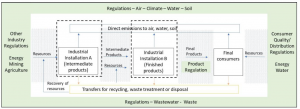Lesson 2 – Industrial Emissions and EU Legislation
Welcome to lesson 2 of the online course on Industrial Emissions and EU Legislation. In this course, we will explore the various policies and regulations established by the European Union to prevent and control industrial emissions.
For some time, industrial emissions have been subject to EU-wide legislation. These policies represent a technology-based approach to prevention and control of industrial emissions, whether or not combined with an environmental quality-based approach. The Industrial Emissions Directive (IED) 2010/75/EU replaced seven earlier pieces of legislation regulating industrial emissions, including IPPC 1996/61/EC and LCP 2001/80/EC.

Using an integrated approach, the IED outlines the main principles for permitting and controlling installations. To ensure compliance with permit conditions, including emission limit values (ELVs), the best available techniques must be used. It is also important to note that the IED creates an important relationship between the permit conditions and the Best Available Techniques (BAT).
In addition to the IED, there are three policy frameworks that we will discuss in this course. The EU Eco-Management and Audit Scheme (EMAS) regulation promotes best environmental management practice (BEMP) through Sectorial Reference Documents (SRDs), which should be considered by registered organisations when assessing their environmental performance. The Directive on Stage I Petrol Vapour Recovery (PVR) aims to reduce emissions from volatile organic compounds caused by the evaporation of petrol. The Medium Combustion Plant Directive (MCP) sets out rules for controlling air emissions of sulphur dioxide (SO2), nitrogen oxides (NOx), and dust from medium combustion plants.
Best Available Techniques (BAT) are usually established at the level of each industrial sector or activity to prevent or reduce emissions and the impact on the environment as a whole. Regulatory authorities typically set requirements for installation operations to prevent or reduce emissions to air, water, soil, energy and water consumption, and waste management through treatment or disposal.
While procedures for establishing BAT aim to consider the most effective technologies and methods available considering the cost and the required site-specific environmental protection benefits, broad accounting of upstream and downstream interactions can be difficult. In general, establishing BAT takes 2 to 4 years with periodic review between 8 to 12 years, requiring resources and time for adequate consideration.
This course will also explore the challenges faced in determining BAT for sector-specific activities, considering the upstream and downstream interactions of the sector’s value chain. We will discuss the impact of environmental regulation, regulatory requirements, and market decisions on industrial installations, which are increasingly fragmented across the globe.
Join us in this online course to gain a comprehensive understanding of Industrial Emissions and EU Legislation in the following lessons.